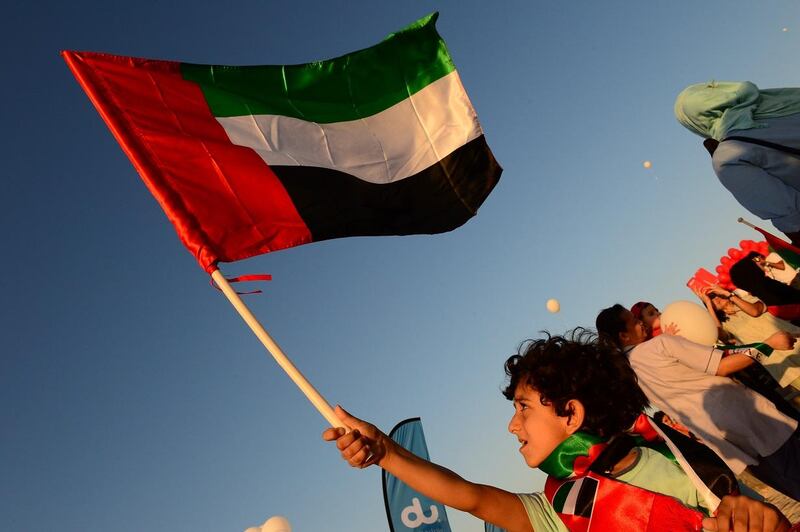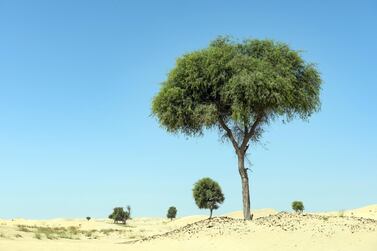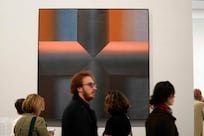The red, white, green and black will be fluttering from windows, rooftops and flagposts on Sunday as the UAE’s national banner adorns homes and is raised ceremonially in schools and government offices across the country in celebration of Flag Day.
This national event, launched in November 2013, marks the anniversary of Sheikh Khalifa bin Zayed’s accession as president of the nation. Every year, on November 3, people across the UAE renew their allegiance, love and dedication to the country’s flag. The government has called on all ministries, schools and institutions to raise the UAE flag at 11am on Sunday as a show of solidarity with the union established by the country’s founding fathers.
As we celebrate Flag Day, I cannot help but reflect on the origins and meaning behind this national symbol, the reasons for countries to have flags and what they say about our humanity.
A flag is more than simply cloth and colour. National flags are universally recognised as representing a country’s identity and people. Since early times, explorers have used flags to proclaim sovereignty over a land. Denmark is widely considered to have the oldest existing flag in the world. Its red flag with a white cross has been used since the 14th century as an emblem of Scandinavia. The flags we wave in the air, fly from buildings and pin as badges near our hearts convey to ourselves and to the world who we are as a nation. They project our aspirations as a country and evoke in us a sense of belonging as individuals. In essence, flags are a significant part of our identity and values.
Various events shape the content and colours that come to represent a national flag. They range from wars and revolutions to public contests. So how can a country’s history, culture, politics and principles fit into one design?
There is, in fact, a specific field of study of flags called vexillology. The term, coined just over 50 years ago by American political scientist Dr Whitney Smith, comes from the Latin word vexillum, meaning a banner carried by ancient Roman cavalry. According to the principles of vexillogy, flags should be simple, have no words, use meaningful symbols – and be unique.
The sun, known as the Sun of May, features in the white and blue flags of both Argentina and Uruguay and represents energy and the rise of a new nation. Crescents typically symbolise Islam, as featured in Tunisia and Pakistan’s flags, while the 50 stars in America’s flag represent its states. Red, white and blue are most commonly used in flags because they are strongly contrasting colours. These tricolours are often featured in the flags of European countries, such as the Czech Republic, France, the Netherlands, Serbia and the UK. While most countries’ flags are rectangular, some use different shapes; Switzerland is the only United Nations member state with a square flag while Nepal’s flag consists of two overlapping red triangles to symbolise the peaks of the Himalayas.
The UAE flag is made of red, white, green and black stripes. The four colours were originally inspired by a verse from 14th century poet Safi Al Din Al Hilli: "White are our acts, black our battles, green our fields, and red our swords." These colours have come to represent the UAE’s fabric of society, weaving together its core values of courage, respect, honour and hope. White is for peace and purity. Black is for strength and power. Green is for prosperity and growth. Red is for bravery and courage, with the vertical band binding all the flag’s colors signalling the UAE’s unity.
The UAE's flag was designed by Emirati Abdullah Al Maainah in 1971 when he was just 19 years old. He posted six flag designs to the authorities after seeing an advertisement for a flag-designing contest in Al Ittihad newspaper. Mr Al Maainah described his feelings of anxiety on waiting to hear the results. He could not sleep the night before the UAE federation was announced.
On December 2, 1971, Abdullah awoke early to witness the raising of the UAE flag atop Al Mushrif Palace in Abu Dhabi. This was the first time he discovered that one of his flag designs was chosen out of the 1,030 samples submitted. He recalls receiving 4,000 riyals as a prize, a large sum at the time, but dwarfed by the honour he felt that his design was chosen as the symbol of the UAE.
Since then, the UAE flag has been respected, revered and recognised all over the world. It has stood atop the world’s tallest building and highest mountain, reached outer space, and has been seen across the land. As we look today upon the UAE flag ruffling in the wind, let us see it as not just a piece of cloth but an embodiment of our aspirations to be a proud, strong and open nation.
Fatima Al Fahim is a writer and Oxford University graduate in public policy






